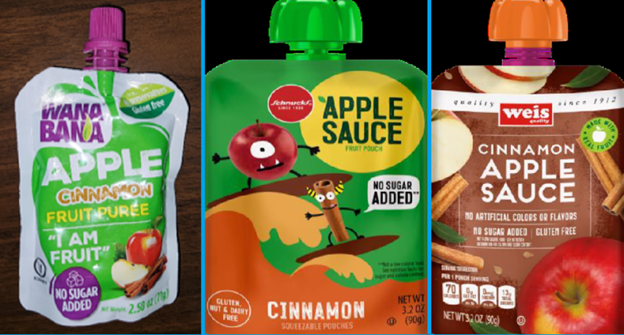What’s Happening?
The North Carolina Departments of Health & Human Services and Agriculture & Consumer Services identified WanaBana cinnamon applesauce pouches as a source for elevated blood lead levels in multiple children. They found extraordinarily high concentrations of lead (1,900- 5,100 ppb) in the products, leading to the identification of at least 34 cases of elevated blood lead levels across 22 states to date.
On October 28, 2023, FDA issued a safety alert advising that “parents and caregivers of toddlers and young children who may have consumed WanaBana apple cinnamon fruit puree pouches should contact their child’s healthcare provider about getting a blood test.” Three days later, the company issued a voluntary recall.
As the recall expanded, FDA transferred the investigation to its Coordinated Outbreak Response & Evaluation (CORE) Network to determine the source of lead contamination and whether additional products are linked to illnesses.
Why It Matters
Lead levels in the puree ranged from 1,900 to 5,100 parts per billion (ppb). A single serving with 2,000 ppb exposed children to a lead level 64 times greater than FDA’s maximum daily intake of 2.2 micrograms/day (µg/day) for a child and 11 times greater than the 12.5 (µg/day) for an adult.
We will continue to note that there is no safe level of exposure to lead—making it toxic at any age, with heightened concern for children aged six and below. In homes without lead pipes or lead paint, diet is the primary source of lead exposure for young children.
Our Take
We applaud both North Carolina and FDA for their timely and effective actions to protect children from these products. The state agencies investigated the household pantry as a potential source of lead exposure, tested the food, and reached out to FDA.
FDA took quick action based on state testing data and issued a safety alert that explicitly advised parents to have their children tested. These were the right steps to take and appear to be a clear break from past actions. For example, health departments that had spent two years attempting to capture FDA’s attention regarding lead in metal cookware that led to elevated blood lead levels in several states. The agency responded with a June 1, 2022 letter with guidance on how to test the cookware and told the recipient to convey the information to firms involved in the marketing or sale of the cookware. The testing procedure was excellent, but FDA has posted nothing about it on its website, despite requests from EDF.
By all indications, the new Deputy Commissioner Jim Jones is already having an impact on how the agency handles chemical safety issues.
As FDA moves forward, there are some important questions the agency needs to address:
- What is the source of the contamination? While apples are often contaminated due to past use of lead arsenate pesticides on orchards, these levels appear to be from cinnamon. In 2019, New York City reviewed 10 years of spice testing and found an average lead level of 2,000 ppb in 19 cinnamon samples, with a maximum of 880,000 ppb.
- Will FDA take action if the company’s voluntary recall is ineffective at getting these products out of families’ pantries?
- Is FDA considering opportunities to strengthen connections between FDA and state and local lead-poisoning-prevention programs. Past issues have made those health department frustrated and less willing to act.
- When will FDA set action levels for foods other than those intended for children younger than two-years old? The proposed action levels for foods other than apple juice apply only to infants and young children and exclude products intended for a broader audience, such as applesauce.
- When will FDA act on the citizen petition EDF and 11 other organizations submitted in December 2020, in which we urged the agency to revise its existing guidelines regarding lead in spices, other ingredients and food contact materials?
Next Steps
We will continue to monitor FDA’s investigation and encourage the agency to address the questions we have.
Go Deeper
Read our previous blogs on lead in food.
Download a PDF of this blog post.











One Comment
good blog